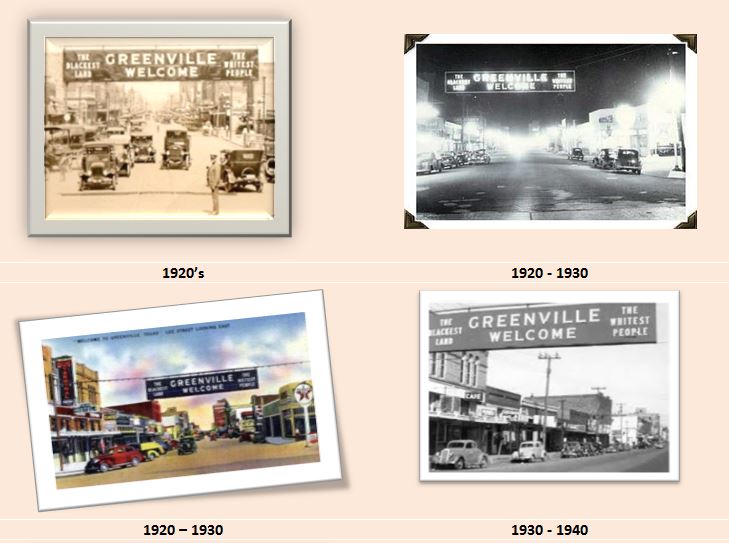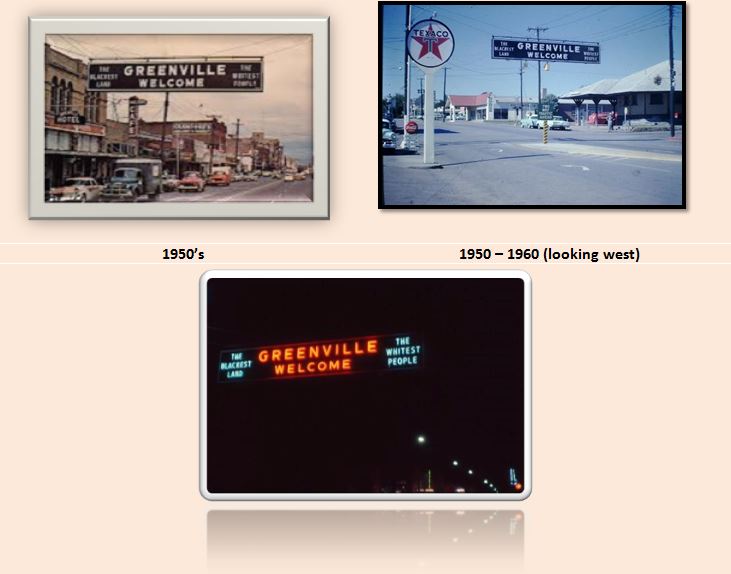|
Greenville Slogan on Card Intrigued Wilson
Harrison Guest of President
Tourists and visitors who come to Greenville usually remember the city’s famed welcome sign. “The Blackest Land and the Whitest People” which flashes its greeting on West Lee Street near the Katy depot. On June 15, 1949, the present new sign received a “face-lifting” to better welcome the city’s visitors. The sign was taken down and completely reworked after it was damaged several months previously when it was hit by a truck. The sign first came into prominence through an incident which occurred in Kansas City in February 1916 when the unusual phrase caught the attention of President Woodrow Wilson. The slogan was on a business card belonging to Greenville resident Will N. Harrison. The President was in Kansas City for an address in the evening at the armory on “Preparedness,” presumably as a “feeler” of war sentiment and to test the pulse of the middle west in shaping his campaign for re-election. Mr. Harrison was in Kansas City heading a delegation from Texas to the national convention of the Jefferson Highway Association. Before the day of federal and state aid, cardinal highways had to be prompted by associations of public spirited citizens.
Not “Original Wilson Man”
Although he had not been an “original Wilson man,” Mr. Harrison had, with customary Democratic regularity, voted for Wilson in 1912 after Judson Harmon, conservative Democrat, whom Mr. Harrison favored, lost the nomination to Wilson. Pleased with the fact that the president had thus far kept the country out of the European war, Mr. Harrison wanted to meet the president and sent up his card from the hotel lobby. He was told by the bellboy that the president would not see anyone before the speech of the evening. A man named Tumulty gave Harrison’s card to Wilson. President Wilson immediately confided that he had not planned to see anyone until after his speech in the evening, but when Mr. Tumulty showed him Mr. Harrison’s card carrying the phrase “Blackest Land – Whitest People, “ he was so attracted by its unusualness and originality, he wanted to meet the man who carried that printed on his cards.
Attracted Wide Interest
This incident when reported locally, attracted wide interest and focused the attention of Greenville leaders on the advertising value of the phrase as a slogan for the city. E. C. Bracken, secretary of the Chamber of Commerce, had been on the Kansas City trip with Mr. Harrison. Bracken immediately began to use the phrase in Chamber of Commerce publicity and its popularity grew into its official adoption as Greenville’s slogan, an act which was culminated in the erection of the electric “welcome” sign by the Chamber of Commerce on July, 7, 1921. Will N. Harrison had been in the land business since 1886. He operated under the name “Will N. Harrison, The Land Man.” Always a great believer in advertising, he had for many years prior to the Kansas City incident, appropriately carried “Blackest Land – Whitest People” printed in tiny letters in the upper corners of his business card. He never used the article “the” before the two phrases as it appears on the sign. There are many people today who believe the sign would be more effective if this mistake had not been made in supplying the copy to the sign manufacturers. Mr. Harrison died on June 5, 1916 just four months after his meeting with President Wilson in Kansas City but he left behind him a slogan which was destined to make known throughout the United States the Greenville and Hunt County which he loved so dearly. A native of Greenville and a descendant of the pioneers who founded the town and county he had, from his boyhood home two blocks south of the public square, fondly and proudly watched the town grow from a little village. He enjoyed nothing more than having a part in this growth. Few men probably have ever loved their home town more sincerely and unselfishly than he did. He was a veritable one man Chamber of Commerce long before there was such a civic organization. In the early days when prominent visitors from the north and east chanced to stop in Greenville, Mr. Harrison would, at his own expense, hire a two-horse rig and drive the party over Hunt County’s fine black land, the while extolling the virtues of the soil and the character of the people. He was sold 100 per cent on the belief that this was the best place and these the best people on earth. One of his business slogans of which he was proudest was “I am responsible for more people living in their own homes in Greenville and Hunt County than any other man. “ In the early days of the century he assisted in organizing the Greenville Commercial Club and served without pay as its secretary until the town grew larger and the Booster Club was formed. In this he was also a prime mover. When this organization developed into the Chamber of Commerce he labored actively in it, serving as one of its presidents and at the time of his death was chairman of the Executive Committee of the organization.
Sign Erected in 1921
The electric “welcome” sign bearing the slogan was erected by the Greenville Chamber of Commerce in 1921 under the presidency of the late Dr. Joe Becton, who was a leader in the movement. V. E. Conway was Secretary of the organization at the time. The sign, measuring four by 24 feet, was purchased from the Flexlume Sign Co., of Buffalo, N. Y. at considerable expense, according to press notices at the time, through Chamber of Commerce committees. The Junior Chamber of Commerce headed by its president, Lee M. Poole, rendered valuable assistance. One of the largest contributions raised by an individual committee was probably that of the railroad men whose committee chairman was W. C. Leftwich, then M-K-T agent. According to The Evening Banner of July 5, 1921, “Commissioner H. L. McLow personally supervised the erection” of the sign and the care of the sign has remained largely under the guardianship of City Commissioner No. 1, a post now held by Scott Wright. On the evening of July 7, 1921, at 8:30 o’clock the sign was formally unveiled, dedicated and presented to the people of Greenville and Hunt County with an elaborate program. According to The Greenville Evening Banner of July 8, 1921, Dr. Joe Becton, president of the Chamber of Commerce, made the formal presentation of the sign. His daughter, Mrs. Jess F. Boykin, pulled the ropes that unveiled it. Quoting from The Banner, “The unveiling by Mrs. Boykin followed an elaborate program which was in no small part devoted to eulogizing the late Will N. Harrison – a civic leader who originated the slogan of Greenville, “The Whitest People, The Blackest Land.”
Exemplified Character of People
Dr. Becton introduced Major Joseph F. Nichols, who, according to The Banner report, “explained that the clause “The Whitest People” exemplified the character of the people who live in Hunt County.” President Lee M. Poole of the Junior Chamber, stated The Banner “paid high tribute to the efforts and services of the membership of the Greenville Chamber of Commerce in securing the sign and at the conclusion of his remarks introduced the Hon. L. L. Bowman, who spoke in a reminiscent vein of the later Mr. Harrison, whom he said he had known intimately for nearly a score of years. Mr. Harrison, he said, had been a friend to more people in Hunt County than any one man of his day or before or since. The thought and personal effort given to the betterment of the community by Mr. Harrison was vividly recalled by the speaker. The several colleges, highways and many other improvements were visioned and in a large part realized in his effort, Mr. Bowman said. Hubert M. Harrison, eldest son of the late Will N. Harrison, and at the present vice president and general manager of the Wichita Falls Chamber of Commerce,” according to The Banner, was introduced and responded to the tribute to his father.
Greenville Evening Banner – Centennial Edition – Sunday, May 7, 1950


Back to Cities & Towns page
|

